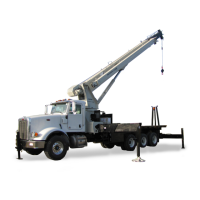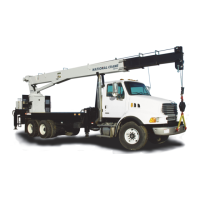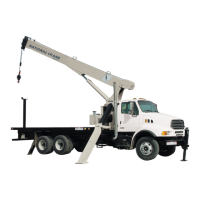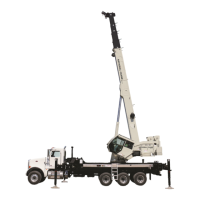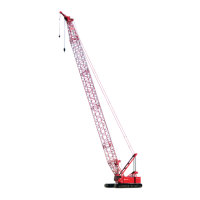National Crane Published 8-01-2017 Control # 287-11 9-29
NBT40 SERVICE MANUAL CRANE INSTALLATION
Rated Load Table
4. Two test loads are required to ensure the crane is stable
over both the sides and rear of the machine.
5. Special care must be taken in performing the stability
test if the crane is equipped with a jib extension. The
stability test can be performed with or without the jib
stowed on the side of the main boom.
Be sure to select the correct load capacity chart; the
charts are titled - with stowed extension or without
extension.
NOTE: Be sure the weights lifted are accurate. A 1%
increase in load weight can result in a 10%
increase in stability test weight required.
NOTE: The following Stability Test EXAMPLES show
boom length, radius and lift capacities, these
numbers should be used for the following
EXAMPLE Stability Test ONLY. T hey are not
meant to be and should not be used for this
machines Stability Test.
Always refer to the load capacity chart provided
with your machine for boom length, radius and
capacity.
EXAMPLE: Test Load #1 - NBT40/45 without
extension
• NBT40-127 5-Section Boom, without extension, O/R
fully extended, capacity at:
- 103 ft (32 m) boom length
- 95 ft (29 m) radius
- 2,250 lb (1020.6 kg) per capacity chart
• Stability Test Load (no extension stowed):
- 2,250 lb x 1.176 = 2646 lb
- 1020.6 kg x 1.176 = 1200.23 kg
EXAMPLE: Test Load #2 - NBT40/45 with stowed
extension
• NBT40-127 5-Section Boom, with stowed extension,
O/R fully extended, capacity at:
- 79 ft (32 m) boom length
- 60 ft (18.3 m) radius
- 6,450 lb (2925.7 kg) per capacity chart
• Stability Test Load (with extension stowed):
- 6450 lb x 1.176 =7585.2 lb
- 2925.7 kg x 1.176 = 3440.6 kg
6. Over the side:
• Assemble the first stability test load as described
above near the crane.
• Measure the load radius from the center of rotation
directly to one side of the machine.
• Extend the boom to the specified boom length
• Lift the stability test load just slightly off the ground
(not over 1 ft 0.3 m).
• Slowly boom down while hoisting up to move the
load out to the load radius.
• Move the load very slowly when approaching the
load radius so the stability test load does not swing
out past the load radius. If the stability test load can
be kept from contacting the ground at the load
radius, the unit is stable over the side tested.
• Slowly rotate the load 360° to ensure that the
stability test load is stable directly over both sides,
the back, and the front.
Model Boom Length Loaded Radius
40103 91 85
103 100
40127 115 110
127 110
40142 128 105
142 100
45103 91 85
103 100
45127 115 110
127 110
45142 115 105
128 110
36103 91 80
103 95
36127 115 90
127 95
DANGER
Stability test conditions represents overloads at crane
positions where boom weight and CG location make up a
large portion of the overturning moment. Great care
should be taken to control boom position and keep hook
load close to the ground. Test loads should not be allowed
to swing out past rated radius. If overturning caused by
the load is allowed to start, and boom angle gets too low,
boom weight may cause the unit to upset.
Reference Only

